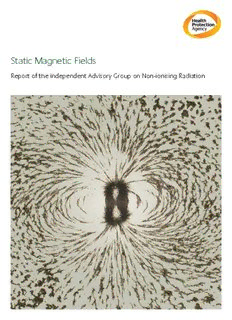
Static Magnetic Fields (PDF, 1.5 MB) - Health Protection Agency PDF
Preview Static Magnetic Fields (PDF, 1.5 MB) - Health Protection Agency
Static Magnetic Fields Report of the independent Advisory Group on Non-ionising Radiation RCE-6 Static Magnetic Fields Report of the independent Advisory Group on Non-ionising Radiation Documents of the Health Protection Agency Radiation, Chemical and Environmental Hazards May 2008 Contents Foreword v Advisory Group on Non-ionising Radiation Membership vii Static Magnetic Fields 1 Executive Summary 3 1 Introduction 5 2 Sources, Exposures and Measurements 8 2.1 Quantities and units 8 2.2 Magnetic environment 9 2.3 Magnetic resonance imaging 12 2.4 Other static magnetic field sources 20 2.5 Measurement equipment 28 2.6 Summary and conclusions 31 2.7 References 32 3 Mechanisms for Biological Interaction 35 3.1 Electrodynamic interactions 35 3.2 Magnetomechanical interactions 37 3.3 Electrodynamic interactions in body tissue 38 3.4 Magnetomechanical interactions in body tissue 46 3.5 Summary and conclusions 48 3.6 References 49 4 Cellular Studies 52 4.1 Genotoxic effects 52 4.2 Changes in cellular processes 58 4.3 Orientation 60 4.4 Summary and conclusions 63 4.5 References 64 iii 5 Animal Studies 67 5.1 Cancer-related endpoints 67 5.2 Reproduction and development 69 5.3 Physiological and behavioural responses 72 5.4 Summary and conclusions 90 5.5 References 91 6 Human Exposures: Experimental Studies 97 6.1 Cardiovascular effects 97 6.2 Cognitive, neurological and sensory effects 100 6.3 References 115 7 Human Exposures: Epidemiological Studies, Randomised Trials and Case Reports 117 7.1 Cancer 117 7.2 Reproductive and developmental outcomes 120 7.3 Therapeutic trials using static magnetic fields 122 7.4 Immune function 122 7.5 Other health outcomes 126 7.6 Summary and conclusions 127 7.7 References 127 8 Conclusions 130 8.1 Sources, exposures and measurements 130 8.2 Mechanisms for biological interaction 131 8.3 Cellular studies 132 8.4 Animal studies 133 8.5 Human exposures 133 9 Research Recommendations 135 9.1 Sources, exposures and measurements 135 9.2 Mechanisms for biological interaction 136 9.3 Cellular studies 136 9.4 Animal studies 136 9.5 Human exposures 137 Glossary 139 Appendix Publications of the independent Advisory Group on Non-ionising Radiation 143 iv Foreword The Health Protection Agency has a statutory responsibility for advising UK government departments on health effects and standards of protection for exposure to ionising and non-ionising radiations. This responsibility came to the Agency in April 2005 when it incorporated the National Radiological Protection Board (NRPB) as its Radiation Protection Division (RPD). In 1990, to provide support for the development of advice on non-ionising radiations, the Director of the NRPB set up the Advisory Group on Non-ionising Radiation with terms of reference: ‘to review work on the biological effects of non-ionising radiation relevant to human health and to advise on research priorities’ The Advisory Group was reconstituted in 1999 as an independent body and now reports to the subcommittee of the Board of the HPA that deals with radiation, chemical and environmental hazards. Its current membership is given on page vii of this report. For details of its work programme, see the website www.hpa.org.uk. The Advisory Group has, to date, issued a number of reports concerned with exposures to electromagnetic fields (EMFs). It has considered a their possible association with an increased risk of cancer, including childhood leukaemia, b neurodegenerative disease, c corona ions and increased particle deposition near power lines, d melatonin, breast cancer and exposure to power frequency fields, e health effects related to the use of visual display units, f potential health effects of radiofrequency fields. Details of publications by the Advisory Group are given in an appendix. In this report the Advisory Group considers the available scientific evidence from studies of people, animals and cells relating to health effects from exposure to static magnetic fields. The report is limited to direct biological effects of static fields, and therefore does not review the evidence on two known indirect effects that can affect health – the risk of accidental injury from flying metal objects attracted by the magnet (‘the projectile effect’), and the effect of magnetic fields on implanted electrical devices and implanted metallic devices. Some emphasis is placed on static field exposures resulting from the use of magnetic resonance imaging (MRI) procedures in medical diagnosis. The report is about static magnetic fields, not MRI per se, however, and therefore does not consider other non-ionising radiation exposures from MRI. v Advisory Group on Non-ionising Radiation Membership CHAIRMAN Professor A J Swerdlow Section of Epidemiology, Institute of Cancer Research, University of London MEMBERS Professor L J Challis University of Nottingham Professor D N M Coggon University of Southampton Dr L A Coulton University of Sheffield Professor S C Darby Clinical Trials Service Unit, University of Oxford Professor P A Gowland University of Nottingham Professor P Haggard Institute of Cognitive Neuroscience, University College London Professor D J Lomas Addenbrooke’s Hospital, University of Cambridge Professor D Noble University of Oxford SECRETARIAT Dr S M Mann Health Protection Agency, Chilton OBSERVER Dr H Walker Department of Health, London vii HPA REPRESENTATIVES Dr A F McKinlay Health Protection Agency, Chilton Dr C R Muirhead Health Protection Agency, Chilton Dr R D Saunders Health Protection Agency, Chilton Dr J W Stather Health Protection Agency, Chilton CONSULTANTS Mr S G Allen Health Protection Agency, Chilton Dr Z J Sienkiewicz Health Protection Agency, Chilton viii
Description: